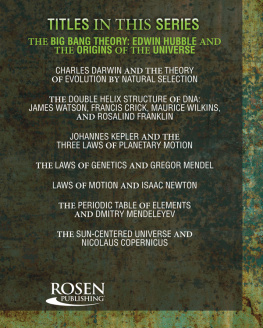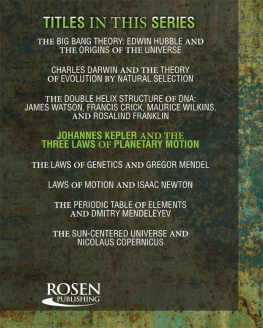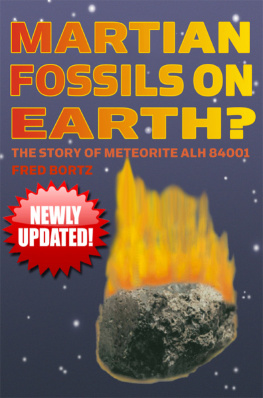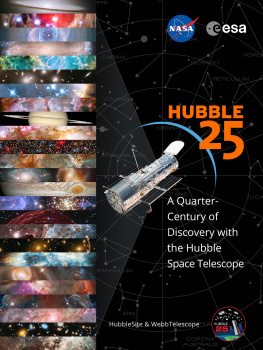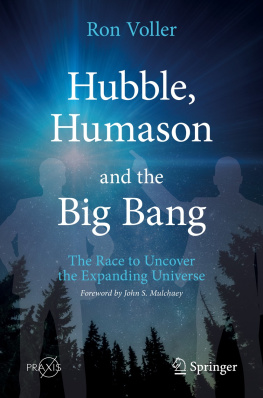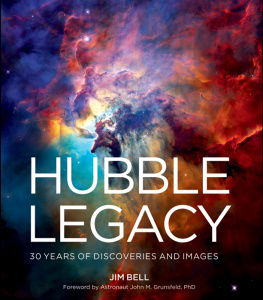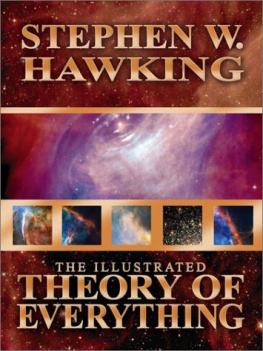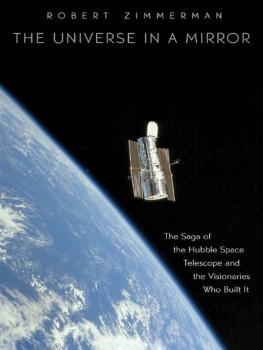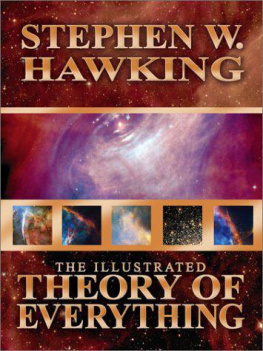

Published in 2014 by The Rosen Publishing Group, Inc.
29 East 21st Street, New York, NY 10010
Copyright 2014 by The Rosen Publishing Group, Inc.
First Edition
All rights reserved. No part of this book may be reproduced in any form without permission in writing from the publisher, except by a reviewer.
Library of Congress Cataloging-in-Publication Data
Bortz, Fred, 1944 author.
The big bang theory: Edwin Hubble and the origins of the universe/Fred Bortz. First edition.
pages cm.(Revolutionary discoveries of scientific pioneers)
Includes bibliographical references and index.
ISBN 978-1-4777-1803-2 (library binding)
1. Hubble, Edwin Powell, 18891953Juvenile literature. 2. Astronomers
United StatesBiographyJuvenile literature. 3. GalaxiesJuvenile literature.
4. Expanding universeJuvenile literature. I. Title.
QB36.H83B67 2014
523.1'8dc23
2013011361
Manufactured in the United States of America
CPSIA Compliance Information: Batch #W14YA: For further information, contact Rosen Publishing, New York, New York, at 1-800-237-9932.
A portion of the material in this book has been derived from Hubble and the Big Bang by Paul Kupperberg.
CONTENTS
CHAPTER ONE:
THE MAKING OF A YOUNG ASTRONOMER
CHAPTER TWO:
FROM ASTRONOMY TO COSMOLOGY
CHAPTER THREE:
GALAXIES
CHAPTER FOUR:
LOOKING BACKWARD IN TIME
CHAPTER FIVE:
HUBBLES CELEBRITY AND LEGACY
INTRODUCTION
T his is a book about the biggest subject you can imagine: the whole universe, and how humanitys ideas about the universe have changed. It is also about a person whose discovery extended the limits of the universe far beyond what others had imagined. In the late 1920s, he not only discovered the farthest reaches of space, but also, much to the astonishment of scientists everywhere, found clues to the beginning of time. That person was American scientist Edwin Powell Hubble, whose work transformed the field of science known as cosmology, the study of the origins, history, and future of the universe.
Although Hubbles revolutionary discovery transformed sciences view of Earths place in space, it was hardly the first such revolution. Humanitys view of the universe had changed dramatically many times since the earliest humans looked to the sky. To them, everything seemed obvious. An unmoving world was at the center of everything, and the sun, moon, planets, and stars circled around it, each following its own path.
In the sixteenth century, the first great revolution challenged that view of the universe. Nicolaus Copernicus placed the sun at the center, added Earth to the planets in orbit around the sun, and set it spinning on its axis. In the early seventeenth century, Johannes Kepler did calculations that showed that the orbits of planets were not perfect circles. He found three mathematical laws to describe their motion. At around the same time, Galileo Galilei made observations with his telescopes that showed that planets were other worlds. And late in that century, Sir Isaac Newton discovered the laws of motion and gravity that explained why Keplers formulas had the mathematical form that they did.

ASTRONOMER EDWIN HUBBLES DISCOVERIES ABOUT GALAXIES DRAMATICALLY CHANGED OUR UNDERSTANDING OF THE SIZE OF THE UNIVERSE AND ITS HISTORY. IN TRIBUTE TO THAT REVOLUTIONARY WORK, NASA NAMED THE HUBBLE SPACE TELESCOPE (HST) AFTER HIM. SINCE ITS LAUNCH IN 1990, THE HST HAS PRODUCED IMAGES THAT HAVE LED TO DISCOVERIES AS REMARKABLE AS THE ONES MADE BY HUBBLE HIMSELF. THE HUBBLE EXTREME DEEP FIELD IS A LOOK SO FAR INTO SPACE THAT IT SHOWS GALAXIES FROM A TIME WHEN THE UNIVERSE WAS LESS THAN A TENTH OF ITS CURRENT AGE.
None of those revolutionaries moved the sun from the center of everything, but by the mid-nineteenth century, astronomers realized that the sun was just one of many stars. Then in 1905, another revolution in cosmology began when Albert Einstein announced a groundbreaking theory of space and time. He stated that the position and motion of any body can be measured only in relation to another body and not in relation to any particular point. No point in the universe is special; that means it has no center at all. Ten years later, he extended that theory to explain gravityyet another revolutionary idea. His mathematics was brilliant, but it required one peculiar quantity called the cosmological constant. Despite the success of his theory of relativity, Einstein found the need for that constant troublesome.
Then along came Hubble. His discoveries revealed a universe that was not only millions of times larger than people had ever before imagined, but one that was also expanding like a balloon. Einstein even thought that Hubbles findings solved the problem of the cosmological constant.
The latest astronomical observations show that Einstein was probably wrong to jump to that conclusion. Those discoveries have set in motion yet another revolution in cosmology. It is too soon to know where that revolution will lead, but it is not too soon to say that whatever path it takes will be grounded in the legacy of Edwin Powell Hubble.

W hen Edwin Hubble was born in Marshfield, Missouri, on November 20, 1889, no one could have imagined that he would grow up to transform a field of science. But it did not take long for his interest in astronomy to become obvious to everyone. Edwins grandfather, William Henderson James of Springfield, Missouri, owned a small telescope that he kept set up in his backyard. During a summer visit in 1897, Edwin spent hours in the evenings peering through the amazing device, watching the progress of celestial objects as they moved across the night sky. He was so fascinated by what he saw that he had only one present in mind for his upcoming eighth birthday: to spend the entire night, from dusk to dawn, observing the heavens through the lens of his grandfathers telescope.

HUBBLE LIVED IN A TIME OF GREAT TECHNOLOGICAL CHANGE. IN 1896, THE YEAR HE TURNED SEVEN YEARS OLD, HENRY FORD (ABOVE) BUILT THE FIRST AMERICAN CAR. THIS PHOTOGRAPH FROM THE LIBRARY OF CONGRESS HAS BEEN PAINTED WITH AN AMERICAN FLAG OF THAT TIME AND A PATRIOTIC MESSAGE.
Little more than twenty-seven years to the day later, on November 24, 1924, that same dogged determination would bring Edwin Hubble to the attention of the world as the man who would forever change humankinds concept of the universe and our place in it.

HUBBLE WAS BARELY FOURTEEN YEARS OLD WHEN ORVILLE AND WILBUR WRIGHT MADE THE FIRST SUCCESSFUL POWERED AIRPLANE FLIGHT WITH A HUMAN ON BOARD AT KITTY HAWK ON NORTH CAROLINAS OUTER BANKS. MANY SCIENTISTS REGARD HUBBLES WORK TO BE AS GREAT A BREAKTHROUGH IN ASTRONOMY AS THE WRIGHT BROTHERS INVENTION WAS IN TECHNOLOGY.
FAMILY LIFE

